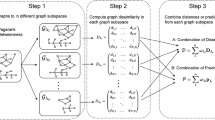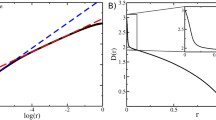Abstract
In this paper, the classification power of the eigenvalues of six graph-associated matrices is investigated. Each matrix contains a certain type of geometric/ spatial information, which may be important for the classification process. The performances of the different feature types is evaluated on two data sets: first a benchmark data set for optical character recognition, where the extracted eigenvalues were utilized as feature vectors for multi-class classification using support vector machines. Classification results are presented for all six feature types, as well as for classifier combinations at decision level. For the decision level combination, probabilistic output support vector machines have been applied, with a performance up to 92.4 %. To investigate the power of the spectra for time dependent tasks, too, a second data set was investigated, consisting of human activities in video streams. To model the time dependency, hidden Markov models were utilized and the classification rate reached 98.3 %.








Similar content being viewed by others
Notes
Databases of the Institute of Computer Science and Applied Mathematics in Bern, Switzerland. http://www.iam.unibe.ch/fki/databases/iam-graph-database.
References
Bigalke L (2011) Erkennung zusammengesetzter Nutzeraktivitäten mittels geschichteter Hidden-Markov-Modelle. diploma thesis, University of Ulm
Bishop CM (2007) Pattern recognition and machine learning (Information Science and Statistics). Springer, Berlin
Bollobás B (2002) Modern graph theory, graduate texts in mathematics, 2nd edn. Springer, Berlin
Brouwer AE, Haermers WH (2012) Spectra of graphs Universitext. Springer
Bunke H, Allermann G (1983) Inexact graph matching for structural pattern recognition. Pattern Recognit Lett 1(4):245–253
Bunke H, Shearer K (1998) A graph distance metric based on the maximal common subgraph. Pattern Recognit Lett 19(3–4):255–259
Chung FRK (1997) Spectral graph theory no 92 in CBMS regional conference series in mathematics. Oxford University Press, Oxford
Cvetković DM, Doob M, Sachs H (1998) Spectra of graphs: theory and applications, 3rd edn. Vch Verlagsgesellschaft Mbh
Diestel R (2005) Graph theory, graduate texts in mathematics, vol 173, 3rd edn. Springer, Berlin
Durbin R, Eddy S, Krogh A, Mitchison G (1998) Biological sequence analysis: probabilistic models of proteins and nucleic acids. Cambridge University Press, Cambridge
Garey MR, Johnson DS (1990) Computers and intractability; a guide to the theory of NP-completeness. W. H. Freeman & Co, San Francisco
Glodek M, Bigalke L, Schels M, Schwenker F (2011) Incorporating uncertainty in a layered HMM architecture for human activity recognition. In: Proceedings of the joint workshop on human gesture and behavior understanding (J-HGBU’11), ACM, pp 33–34
Juang BH, Rabiner LR (1991) Hidden markov models for speech recognition. Technometrics 33(3):251–272
Luo B, Wilson RC, Hancock ER (2003) Spectral embedding of graphs. Pattern Recognit 36(10):2213–2230
McLachlan G, Peel D (2000) Finite mixture models. Wiley series in probability and statistics: applied probability and statistics. Wiley, London
Murphy K (1998) Hidden markov model (HMM) toolbox for Matlab, http://www.cs.ubc.ca/murphyk/Software/HMM/hmm.html
Rabiner LR (1989) A tutorial on hidden markov models and selected applications in speech recognition. Proc IEEE 77:257–286
Riesen K, Bunke H (2008) IAM graph database repository for graph based pat-tern re -cog -ni -tion and machine learning. In: Proceedings of the joint IAPR international workshop on structural, syntactic, and statistical pattern recognition (SSPR &SPR’08). Springer, LNCS 5342:287–297
Riesen K, Neuhaus M, Bunke H (2007a) Bipartite graph matching for computing the edit distance of graphs. In: Escolano F, Vento M (eds) Proceedings of the 6th IAPR-TC-15 international conference on graph-based representations in pattern recognition . Springer, LNCS 4538:1–12
Riesen K, Neuhaus M, Bunke H (2007b) Graph embedding in vector spaces by means of prototype selection. In: Escolano F, Vento M (eds) Proceedings of the 6th IAPR-TC-15 international workshop on graph-based representations in pattern recognition (GbRPR’07) . Springer, LNCS 4538:383–393
Sanfeliu A, Fu KS (1983) A distance measure between attributed relational graphs for pattern recognition. IEEE Trans Syst Man Cybern 13(3):353–362
Schmidt M, Schwenker F (2011) Classification of graph sequences utilizing the eigenvalues of the distance matrices and hidden markov models. In: Jiang X, Ferrer M, Torsello A (eds) Proceedings of the 8th IAPR-TC-15 international workshop on graph-based representations in pattern recognition (GBRPR’11) . Springer, LNCS 6658:325–334
Schmidt M, Schels M, Schwenker F (2010) A hidden markov model based approach for facial expression recognition in image sequences. In: Schwenker F, El Gayar N (eds) Proceedings of the 4th IAPR TC3 workshop on artificial neural networks in pattern recognition (ANNPR’10). Springer, Cairo, Egypt, LNAI 5998:149–160
Scholkopf B, Smola AJ (2002) Learning with kernels: support vector machines, regularization, optimization, and beyond adaptive computation and machine learning. MIT Press, Cambridge
Umeyama S (1988) An eigendecomposition approach to weighted graph matching problems. IEEE Trans Pattern Anal Mach Intell 10(5):695–703
Vapnik VN (1999) The nature of statistical learning theory. Statistics for engineering and information science, 2nd edn. Springer, Berlin
Watson JD, Laskowski RA, Thornton JM (2005) Predicting protein function from sequence and structural data. Curr Opin Struct Biol 15(3):275–284
Wilson A, Bobick A (1999) Parametric hidden markov models for gesture recognition. IEEE Trans Pattern Anal Mach Intell 21(9):884–900
Wilson RC, Hancock ER, Luo B (2005) Pattern vectors from algebraic graph theory. IEEE Trans Pattern Anal Mach Intell 27(7):1112–1124
Acknowledgments
This paper is based on work done within the Information Fusion subproject of the Transregional Collaborative Research Center SFB/ TRR 62 Companion-Technology for Cognitive Technical Systems, funded by the German Research Foundation (DFG). The work of Miriam Schmidt is supported by a scholarship of the Graduate School Mathematical Analysis of Evolution, Information and Complexity of the University of Ulm. The authors want to thank Lutz Bigalke for recording, preprocessing and providing the data for the activity recognition task.
Author information
Authors and Affiliations
Corresponding author
Rights and permissions
About this article
Cite this article
Schmidt, M., Palm, G. & Schwenker, F. Spectral graph features for the classification of graphs and graph sequences. Comput Stat 29, 65–80 (2014). https://doi.org/10.1007/s00180-012-0381-6
Received:
Accepted:
Published:
Issue Date:
DOI: https://doi.org/10.1007/s00180-012-0381-6




